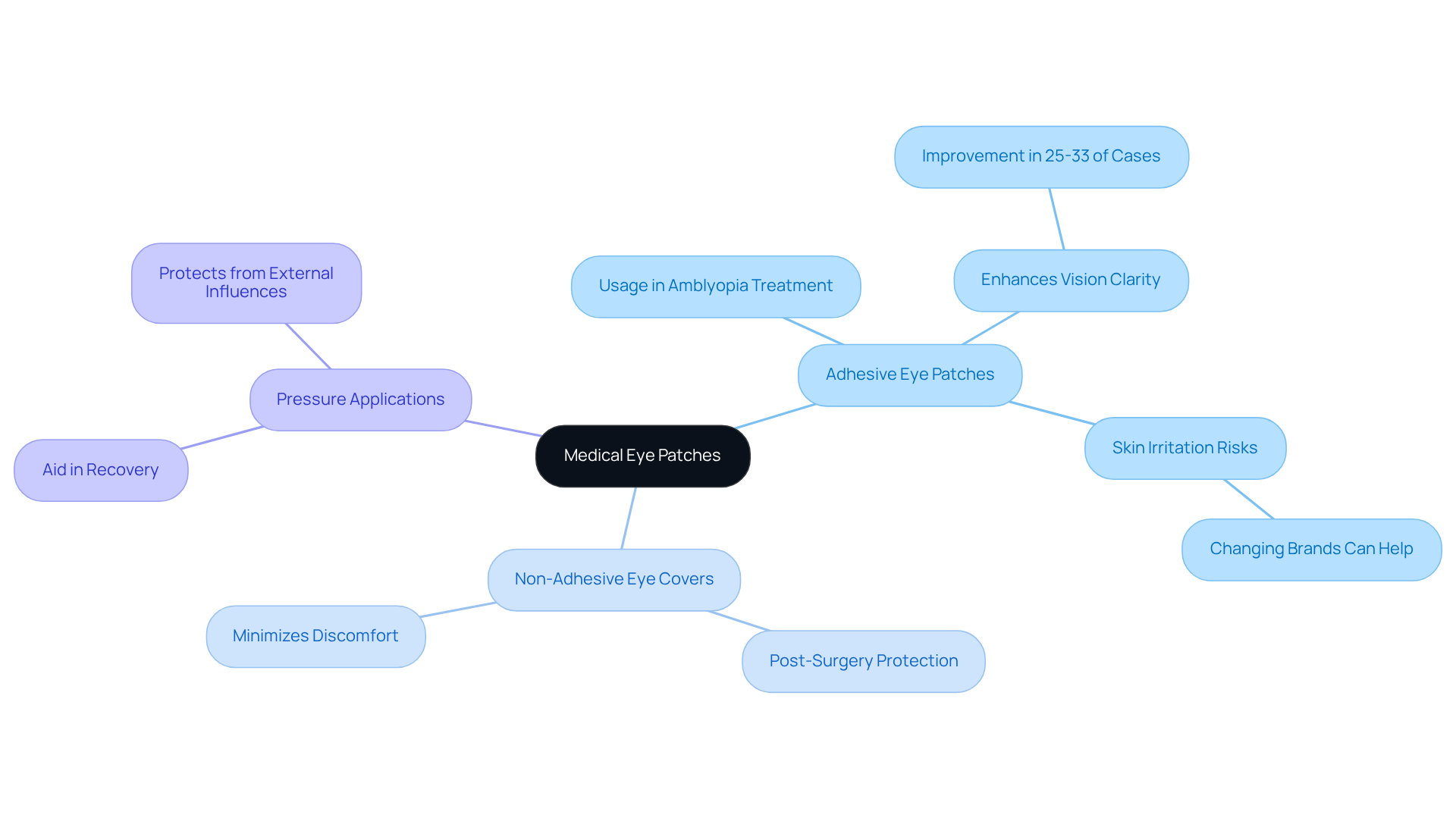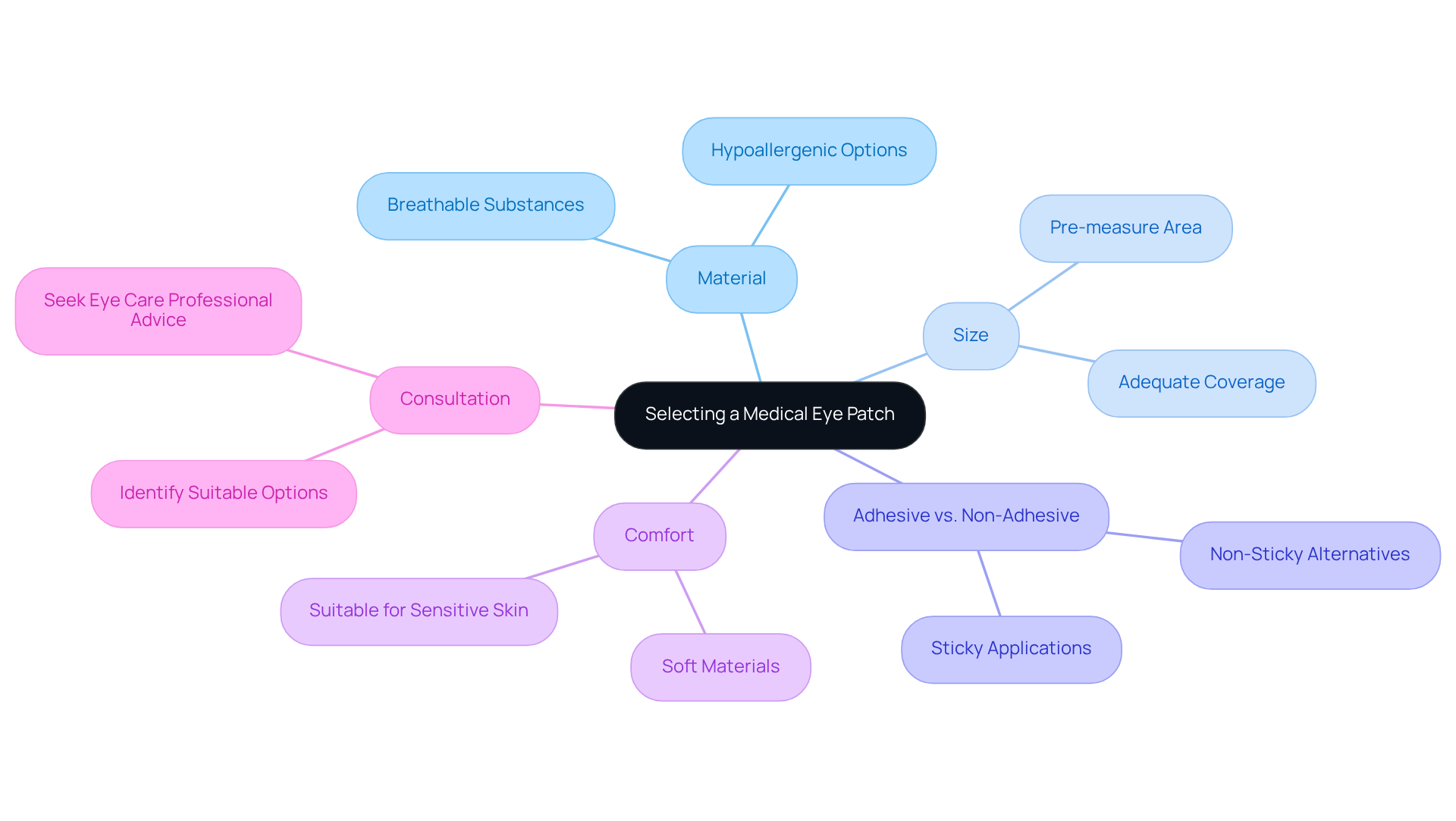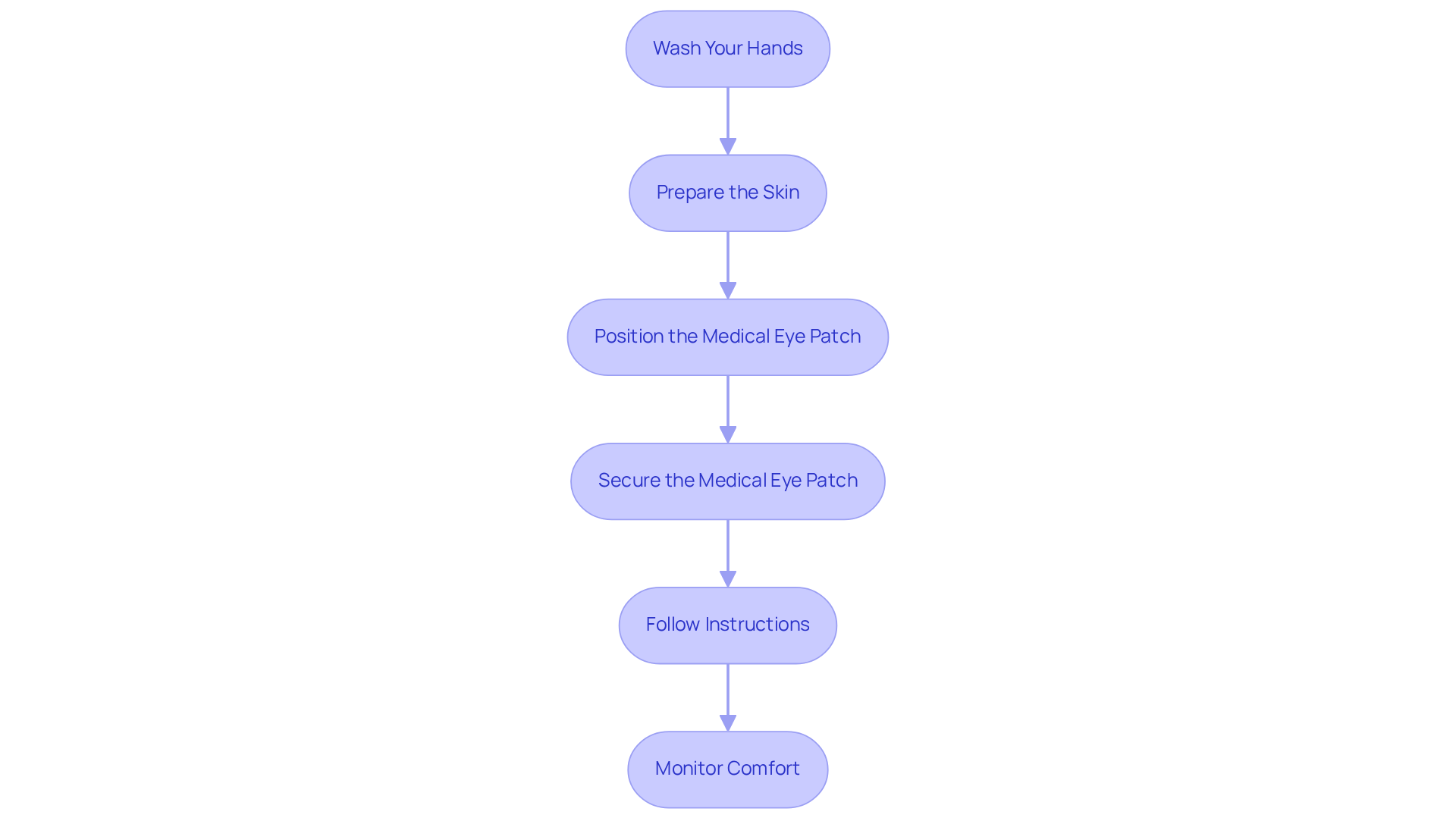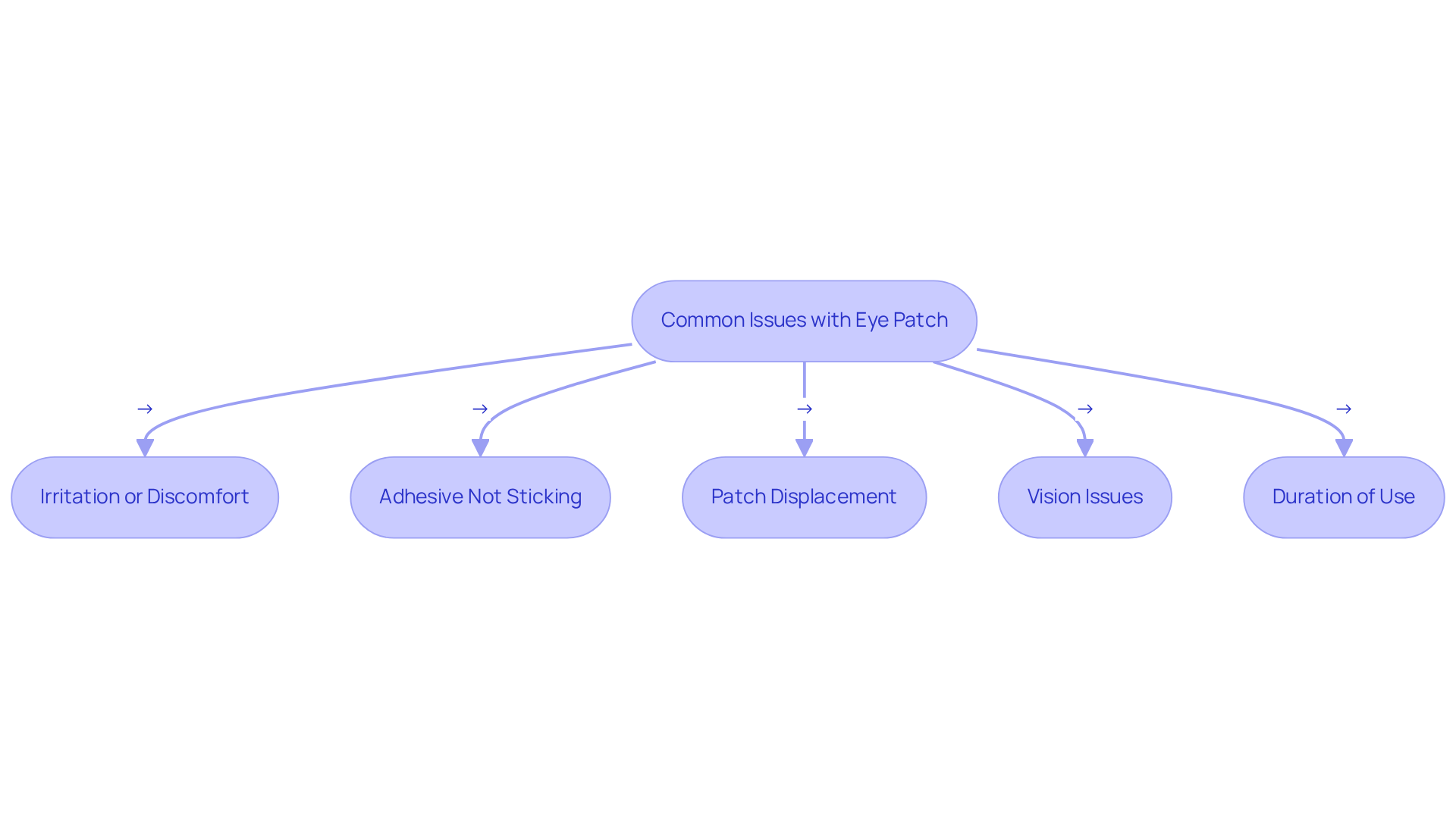Posted by: Northwest Eye in General on July 20, 2025
Overview
This article highlights four essential steps for using a medical eye patch effectively, with a focus on:
- Understanding the types of patches
- Selecting the right one
- Applying it correctly
- Troubleshooting common issues
We understand that navigating eye care can be challenging, and each section provides detailed guidance to help you feel more confident in your choices. Proper usage and adherence to medical advice are crucial for ensuring optimal recovery and managing eye conditions. Remember, we are here to help you through this process.
Introduction
The importance of medical eye patches in promoting eye health is profound. They play essential roles in recovery from surgery, treatment for conditions like amblyopia, and protection from injuries. We understand that navigating through the various types of patches and their effective usage can feel overwhelming. However, doing so can significantly enhance recovery outcomes and improve vision.
It’s common to feel uncertain about selecting the right patch or applying it correctly, which can lead to discomfort or ineffective treatment. To help you, we will explore the key steps to ensure optimal usage of a medical eye patch. Additionally, we will address common issues that may arise during its use, offering supportive guidance to navigate this journey with confidence.
Understand the Purpose and Types of Medical Eye Patches
The use of a medical eye patch plays a crucial role in your recovery and overall eye health. They protect the eye after surgery, aid in treating amblyopia (lazy eye), and help manage symptoms from eye injuries with a medical eye patch. We understand how concerning it can be when pediatric eye assessments reveal and refractive errors. Knowing the reasons behind these challenges is vital for effective treatment.
The main types of medical eye patches include:
- Adhesive Eye Patches: These patches gently adhere to the skin around the eye and are commonly used in amblyopia treatment. By covering the dominant eye with a medical eye patch, they encourage the less effective eye to work harder, which is essential for improving vision. Studies show that patching can enhance vision clarity in 25-33% of cases, making it a vital intervention for children with lazy eye.
- Non-Adhesive Eye Covers: Often held in place by an elastic band or designed to fit over glasses, these covers are frequently used after surgery to protect the eye without sticking to the surface. This type is particularly helpful for patients recovering from procedures, as it minimizes discomfort and skin irritation.
- Pressure Applications: These gentle applications exert light pressure on the eye and are often utilized after specific surgical procedures to aid in recovery and shield the eye from external influences.
Understanding these varieties of medical eye patches is essential for selecting the right option tailored to your needs, whether for treatment or post-operative care. Proper usage and adherence to guidelines can significantly impact recovery and vision improvement. Remember, untreated amblyopia can lead to serious health complications, making timely intervention crucial. We are here to help you through this process, ensuring you receive the care and support you need.

Select the Right Medical Eye Patch for Your Needs
When selecting a , we recognize that comfort and effectiveness are of utmost importance. Here are several key factors to consider:
- Material: Choose coverings made from breathable, hypoallergenic substances to reduce irritation, especially if the covering will be worn for long durations.
- Size: Ensure the dressing adequately covers the entire eye and surrounding area without leaving gaps. Measuring the area beforehand can help in making the right choice.
- Adhesive vs. Non-Adhesive: Decide your preference between sticky applications that attach directly to the surface and non-sticky alternatives that can be fastened with a strap or spectacles.
- Comfort: Choose materials that are soft and pleasant, particularly for children or those with delicate skin when wearing a medical eye patch.
- Consultation: Always seek advice from your eye care professional to identify the most suitable medical eye patch for your specific condition. We are here to help you through this process.

Apply and Use the Eye Patch Correctly for Optimal Results
To apply and use a medical eye patch effectively, please follow these caring steps:
- Wash Your Hands: We understand how important it is to keep everything clean. Start by thoroughly washing your hands with soap and water to prevent introducing any bacteria to the sensitive eye area.
- Prepare the Skin: Ensure the skin around your eye is clean and dry. It’s common to feel concerned about irritation, so avoid using any creams or oils that could disrupt the adherence of the bandage.
- Use a medical eye patch for proper eye protection. Position the medical eye patch: If you’re using a sticking application, peel off the backing and gently place the medical eye patch over the affected eye, ensuring it covers the entire area without gaps. For non-adhesive coverings, position it securely over the eye and use a band or glasses to keep it in place. We are here to help you through this process.
- A medical eye patch is used for various eye conditions. Secure the medical eye patch: Press down gently around the edges to ensure a snug fit. If using an adhesive strip, make sure it sticks properly without causing discomfort. Remember, your comfort is our priority.
- Follow Instructions: Wear the adhesive for the duration recommended by your healthcare provider, which may vary based on your specific condition. It’s important to follow these guidelines to ensure proper healing.
- Monitor Comfort: Check periodically to and secure. If irritation occurs, don’t hesitate to consult your eye care professional. We understand that this can be a bit challenging, but you are not alone.

Troubleshoot Common Issues with Eye Patch Usage
While using a medical eye patch, it’s common to encounter some issues that may cause concern. We understand that this can be frustrating, so here’s how to troubleshoot them:
- Irritation or Discomfort: If the adhesive causes irritation, please ensure that the surface is clean and dry before application. If irritation persists, consider switching to a hypoallergenic adhesive.
- Adhesive Not Sticking: If the covering does not adhere properly, it’s important to check that the skin is free from oils or creams. You may also want to try a .
- Patch Displacement: If the covering shifts from its position, please ensure it is applied securely. For non-adhesive coverings, consider using a tighter band or adjusting the fit of your glasses.
- Vision Issues: If you experience increased discomfort or vision problems while using the medical eye patch, we recommend removing it and promptly consulting your eye care professional.
- Duration of Use: If you find it challenging to wear the patch for the recommended duration, try breaking it into shorter intervals throughout the day. Gradually increasing the time as you become more comfortable can be very helpful.
Remember, we are here to help you through this process, and it’s perfectly normal to have questions and concerns.

Conclusion
Using a medical eye patch effectively is essential for ensuring optimal recovery and enhancing overall eye health. We understand that navigating this process can feel overwhelming, but understanding the purpose and types of eye patches available is the first step toward making informed decisions that can significantly impact your treatment outcomes. By selecting the right patch tailored to your individual needs, you can facilitate healing and improve vision clarity, especially in cases of amblyopia or post-operative care.
When choosing a medical eye patch, it’s important to consider factors like:
- Material
- Size
- Comfort
We also want to guide you on proper application techniques to maximize effectiveness. It’s common to encounter issues during usage, and we provide practical troubleshooting tips to help you navigate any discomfort or challenges. Being aware of these aspects empowers you to take control of your eye care journey.
Ultimately, the significance of using a medical eye patch cannot be overstated. It plays a vital role in protecting your eye and supporting recovery processes. By following the outlined steps and seeking professional guidance, you can ensure you are making the best choices for your eye health. Embracing these practices not only aids in your immediate recovery but also contributes to long-term vision improvement, making it a critical component of effective eye care. Remember, we are here to help you through this process.
Frequently Asked Questions
What is the purpose of a medical eye patch?
A medical eye patch plays a crucial role in recovery and overall eye health by protecting the eye after surgery, aiding in the treatment of amblyopia (lazy eye), and helping manage symptoms from eye injuries.
What are the main types of medical eye patches?
The main types of medical eye patches include adhesive eye patches, non-adhesive eye covers, and pressure applications.
How do adhesive eye patches work?
Adhesive eye patches gently adhere to the skin around the eye and are commonly used in amblyopia treatment. They cover the dominant eye, encouraging the less effective eye to work harder, which is essential for improving vision.
What is the effectiveness of patching for amblyopia?
Studies show that patching can enhance vision clarity in 25-33% of cases, making it a vital intervention for children with lazy eye.
What are non-adhesive eye covers used for?
Non-adhesive eye covers are often held in place by an elastic band or designed to fit over glasses. They are frequently used after surgery to protect the eye without sticking to the surface, minimizing discomfort and skin irritation.
When are pressure applications used?
Pressure applications are used after specific surgical procedures to exert light pressure on the eye, aiding in recovery and shielding the eye from external influences.
Why is it important to understand the types of medical eye patches?
Understanding the varieties of medical eye patches is essential for selecting the right option tailored to individual needs, whether for treatment or post-operative care, as proper usage can significantly impact recovery and vision improvement.
What are the consequences of untreated amblyopia?
Untreated amblyopia can lead to serious health complications, making timely intervention crucial for effective treatment and overall eye health.






